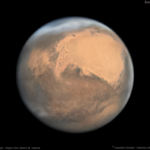*****************************************************
Italiano:
Inserisco, con un aggiornamento del 30 maggio 2025, una terza rielaborazione (cliccate su Newest Processing – best view) dove ho ancora evidenziato leggermente i dettagli e riequilibrato ulteriormente i colori, invertendo la posizione relativa dei poli (col sud in alto). Il mio amico Michele, mi ha fatto notare che al centro e al bordo in basso dell’immagine, sotto la coltre di nubi e al bordo della zona chiara, si vede chiaramente un punto scuro al limite della zona chiara stessa: si tratta del cratere Lyot, di circa 220 Km. di diametro.
Questa ripresa di Marte, lo raffigura così come si presentava il 20 dicembre 2022 mentre si trovava, lungo la propria orbita, in allontanamento dalla Terra, a circa 87,3 milioni di Km., con un diametro angolare apparente di 16,1 secondi d’arco.
Il “Sinus Meridiani” si trovava quasi al passaggio al meridiano centrale marziano con esattamente in zona centrale e in bella vista, il “Meridiani Planum” che contiene al suo interno ciò che sembra un piccolo dettaglio, come un luminoso anello circolare, incastonato nella forma di golfo rivolto verso il basso: si tratta del grandissimo cratere “Schiaparelli” – cratere da impatto di 459 km di diametro -, mentre la zona polare nord (estremità in basso in questa più recente elaborazione, ricoperta dalle nubi bianche) dove si trova la zona più scura “Acidalia Planitia”, è per l’appunto vistosamente ricoperta dalle nubi orografiche che risultano essere a chiazze e un pò “striate” dai venti marziani.
Le nubi orografiche marziane, simili a quelle terrestri, si formano quando il flusso d’aria incontra una catena montuosa o un altro ostacolo topografico, come un vulcano, in cui il vento spinge l’aria verso l’alto, dove si raffredda e si satura di vapore acqueo. Se la temperatura scende al di sotto del punto di congelamento, il vapore acqueo si condensa formando nubi di ghiaccio, che possono assumere forme complesse. Esse sono state osservate in diverse aree di Marte, inclusi i bordi delle calotte polari e i vulcani.
La “Valles Marineris” è visibile sul bordo destro e ancora, la zona polare sud (estremità in alto, nella più recente rielaborazione), spoglia della solita presenza di anidride carbonica ghiacciata, tipica delle calotte polari.
Infine, sull’estremo bordo sinistro, in fase di “tramonto” dal nostro punto di vista terrestre e parzialmente ricoperta da nubi al lembo, si può individuare la “Syrtis Major”.
Grazie dell’attenzione e…. ad maiora semper!
Dettagli Tecnici:
Telescopio Astrofaktorja DK20″ @ ~ F/28 – Televue 2″ PowerMate Barlow 2x – Baader RGB filters – Player One Saturn M camera – Seeing 6,5/10 in R band – sito: Palermo @ my personal Observatory.
****************************************************************************************
English:
With an update of June 02 – 2023, I’m posting a second elaboration where I slightly highlighted the details and further and finely rebalanced the colors. My friend Michele, pointed out to me that in the center and top of the image, under the blanket of clouds and at the edge of the clear area, you can see a dark point at the edge of the light area itself: it is the Lyot crater, of about 220 Km. in diameter.
Here is a shot of Mars as it appear in December 2022 – exactly Tuesday 20 – while it was, along its orbit moving away from the Earth, at about 87.3 million km and with an apparent angular diameter of 16.1″ .
The “Sinus Meridiani” is located almost at the transition to the central Martian meridian with, in plain sight, the “Meridiani Planum” which contains, within it, what looks like a small detail, like a luminous circular ring , set in the shape of a gulf facing upwards, which is none other than the large “Schiaparelli” crater of 459 km in diameter, while the north polar area (top end) where the darker area “Acidalia Planitia” is located , is conspicuously covered by orographic clouds which appear to be patchy and somewhat streaked by the Martian winds.
The “Valles Marineris” is visible on the left edge and again, the south polar area (bottom end) bare of the usual presence of frozen carbon dioxide, typical of the polar caps.
Finally, on the extreme right edge, “Syrtis Major” can be identified in the “sunset” phase from our terrestrial point of view and partially covered by clouds.
Thanks for your attention and…. ad maiora semper!
Technical Details:
Astrofaktorja DK20″ telescope @ ~ F/28 – Televue 2″ PowerMate Barlow 2x – Baader RGB filters – Player One Saturn M camera – Seeing 6.5/10 in R band – site: Palermo @ my personal Observatory.




